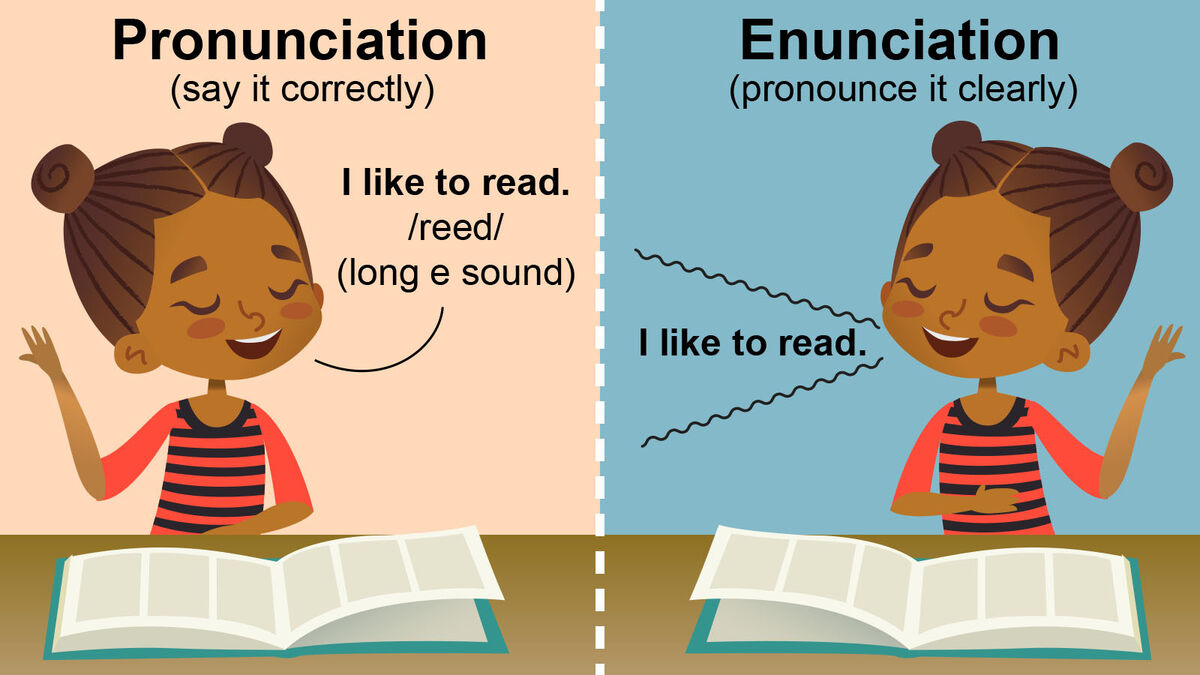
Pronunciation and enunciation are closely related terms that often get confused with each other. Pronunciation is related to the word itself, focusing on which syllables should be emphasized and how certain letters (or combinations of letters) should sound when spoken. Enunciation refers to how clearly and distinctly a particular individual forms the sounds that make up a word.
What Is Pronunciation?
Pronunciation can be defined as how a particular word should sound when spoken aloud. Pronunciation focuses on the sounds a speaker should use for each part of a word and how they should be put together. Proper pronunciation can be challenging because it’s not always possible to tell how a word should be spoken simply by looking at the way it is spelled.
Multiple Pronunciations and Spellings
It’s not unusual for words in the English language to have more than one pronunciation, even though there is no difference in spelling. Some words are spelled differently yet are pronounced the same way. For example, you can pronounce the word “read” two different ways. One of the pronunciations of “read” sounds the same as “red.”
Sentence | Pronunciation | When to Use |
I am planning to read this book. | /reed/ (long e sound) | Present tense Future tense |
She read a story to the child. | /red/ (soft e sound) | Past tense |
The girl wore a red dress. | /red/ (soft e sound) | Color |
Silent Letters
To further complicate pronunciation, many common English words have silent letters. For example:
- Love, dove, and glove are examples of the many words that end with an “e” that is silent.
- Honest and honored are examples of words that begin with an “h” that is not included in the pronunciation.
What Is Enunciation?
Enunciation can be defined as speaking clearly, stating each word fully and distinctly.This is a function of how an individual speaks rather than how a word should be pronounced.
Common Enunciation Problems
Enunciation problems can take several forms. A few examples include:
- Dropping “g” sounds: Saying things like “He’s goin’ to the store” instead of fully forming the “g” sound at the end of the word “going”
- Blending words improperly: Combining words in a manner that is not correct, such as saying “gonna” instead of “going to”
- Speaking too quickly :Talking so fast that words run together so that listeners can’t be sure where one word ends and another begins
- Muttering: Speaking softly, in a manner often referred to as “under your breath” so that other people can’t tell what you are saying
- Mumbling: Speaking indistinctly and in a low voice so that words run together and can be difficult for a listener to distinguish
Overcoming enunciation issues involves not only pronouncing words properly, but also making sure to articulate (speak clearly) each word and to speak up so that your voice properly projects.
How to Improve Enunciation
Improving your ability to enunciate requires practicing how you speak and being mindful of doing so in a way that leads to clear communication that is easily understood by other people. Activities that can help you learn how to enunciate better include:
Self-evaluation: Record yourself having a conversation with another person (with that individual’s permission) to analyze how you are speaking. Be honest with yourself about how you come across. This will help you determine where to focus your efforts.
- Are you talking so fast that some words run together? Practice slowing your rate of speech to a more appropriate pace. Begin by taking a breath between each word.
- Does the listener have to strain to identify the words you are speaking? Practice speaking at a more appropriate volume.
- Are you dropping sounds or combining terms improperly? Cleary state each sound that should be included with every word and use only correct contractions to shorten phrases.
- Articulation practice: Make a list of words you use regularly as well as less familiar terms that are hard to say, then practice speaking them aloud clearly and distinctly. If necessary, look up how these words should be pronounced, then spend time saying each of them out loud very slowly. Exaggerate each sound, leaving sufficient time between words to fully pronounce each one.
- Breathing exercises: Make sure you are breathing properly while you speak. Your stomach muscles should provide support for your diaphragm while you are talking. This will help make sure you have sufficient air to form words clearly and speak at an appropriate pace. Use deep breathing exercises to help improve your ability to breathe properly while speaking.
Pronunciation vs. Enunciation: Both Are Important
In order to communicate effectively, it’s necessary to pronounce words correctly while also enunciating as you speak.
Correct Pronunciation With Poor Enunciation
You could pronounce a word correctly but fail to enunciate properly. For example, you could make the sounds associated with a word correctly (pronunciation) yet mumble as you are speaking or use a rate of speech that is so fast that the words run together (poor enunciation).
Proper Enunciation With Mispronunciation
You could enunciate properly, yet mispronounce a word. You could speak clearly and distinctly (enunciation) yet use the wrong syllable emphasis or letter sounds for the words you are saying (mispronunciation).
Improve Pronunciation and Enunciation
Now that you are familiar with the difference between pronunciation and enunciation, take steps to improve your skills in both areas. Review commonly mispronounced words so you can master how to say them correctly and focus on speaking clearly and distinctly so that other people don’t have to struggle to tell what you are saying. Doing so will help you develop strong verbal and oral communication skills.